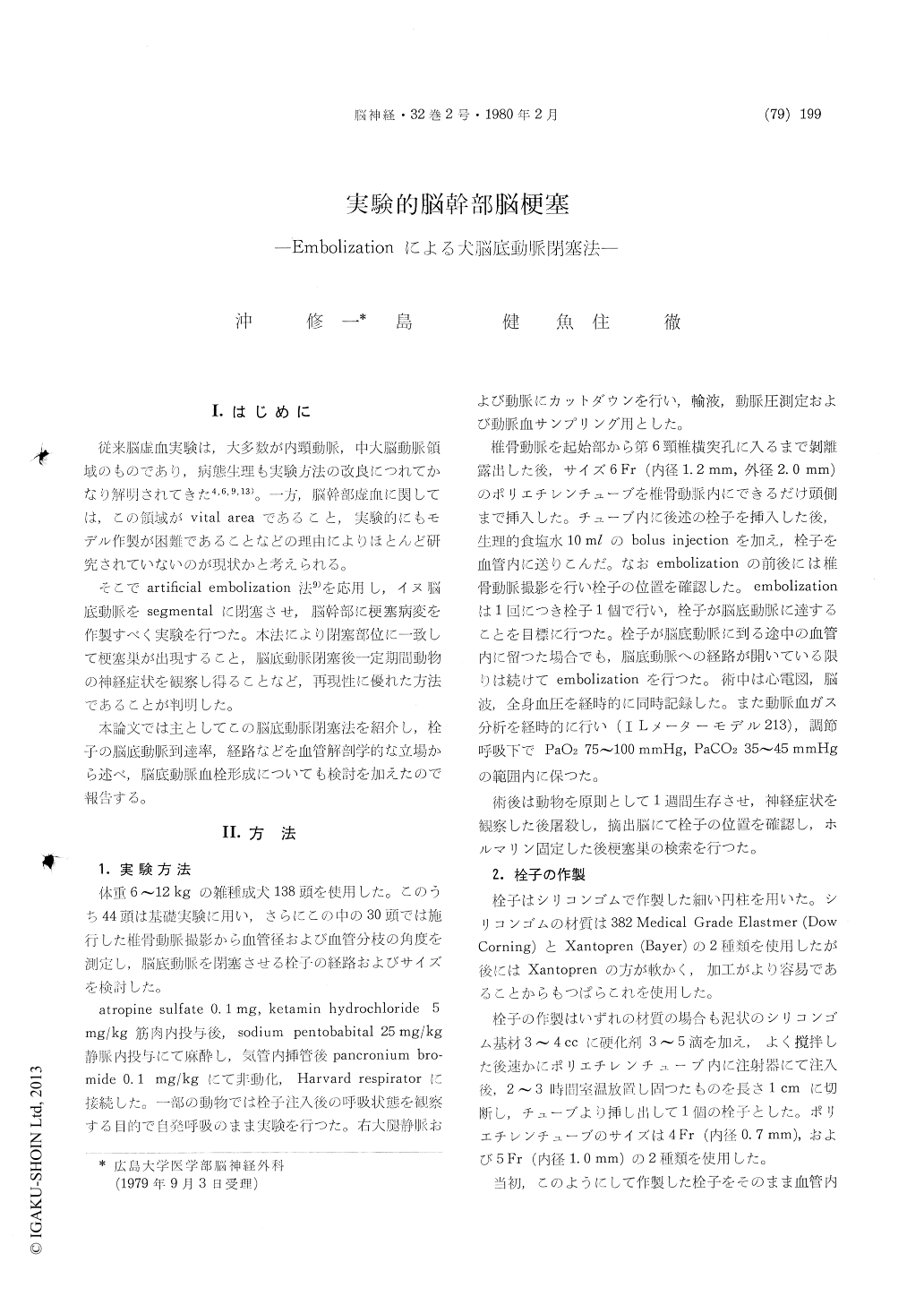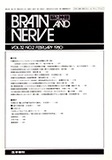Japanese
English
- 有料閲覧
- Abstract 文献概要
- 1ページ目 Look Inside
Ⅰ.はじめに
従来脳虚血実験は,大多数が内頸動脈,中大脳動脈領域のものであり,病態生理も実験方法の改良につれてかなり解明されてきた4,6,9,13)。一方,脳幹部虚血に関しては,この領域がvital areaであること,実験的にもモデル作製が困難であることなどの理由によりほとんど研究されていないのが現状かと考えられる。
そこでartificial embolization法9)を応用し,イヌ脳底動脈をsegmentalに閉塞させ,脳幹部に梗塞病変を作製すべく実験を行つた。本法により閉塞部位に一致して梗塞巣が出現すること,脳底動脈閉塞後一定期間動物の神経症状を観察し得ることなど,可現性に優れた方法であることが判明した。
Very few experiments have been reported on ischemia of the brain stem. No report could be found in the literature on the segmental em-bolization of the vertebrobasilar system.
This report deals with a method of producing brain stem infarction in the dog using segmental embolization technique.
Method: A total of 138 adult mongrel dogs were used in this study, of which 44 were employed in the fundamental experiments on embolization. In 30 cases out of these 44 cases, the diameters of the vessels, branching angles and embolic pathways were measured angiographically. According to author's angiographical criteria, 94 dogs were selected for embolization experiments. The dogs were anesthetized by intravenous administration of sodium pentobarbital. EEG, ECG and systemic arterial blood pressure were recorded simultaneously, and arterial blood gas was analysed with time. A silicone rubber cylinder was injected into the ipsilateral cervical vertebral artery to embolize the basilar artery segmentally.
The cylindrical emboli were 0.7mm (4 Fr) and 1.0mm (5 Fr) in diameter and 10 mm in length, and were made of 382 Medical Grade Elastmer (Dow Corning) or Xantopren (Bayer). In almost all cases the silicone emboli were coated with gutta percha. Angiogram was performed via the catheter inserted into the vertebral artery. The diameter of the vessels and the branching angles were measured by a pair of slide calipers and protractor directly on the X-ray film.
Results: The embolic pathway to reach the basilar artery was the vertebral artery the ventral spinal artery the spinal arterial circle the basilar artery.
The vessels of the canine vertebrobasilar system become large or small at their confluence or branching. Therefore, for the embolization of the basilar artery having a large diameter it was necessary to make the embolus pass through the small vessels. The embolus had to pass through the ventral spinal artery in order to embolize the basilar artery. The branching variations of the ventral spinal artery were divided into 4 types according to the diameter and branching angle. After all, the embolus was thought most likely to pass into the ventral spinal artery when its diameter and branching angle were both larger than those of the distal bertebral artery. In comparison with the diameter and branching angle of the ventralspinal artery, the embolus is more likely to pass into vessels of larger diameter. Conversely, when the ventral spinal artery branches reversely from the proximal vertebral artery, or when the diameter of the ventral spinal artery is remarkably smaller than that of the distal vertebral artery, it is im-possible to embolize the basilar artery.
In 81 out of 94 dogs, 86.2%, the embolus obstructed the intracranial arteries, while in 13.8% the embolus was located in the extracranial portion. The emboli were lodged in the basilar head in 46.8% and in the spinal arterial circle in 49.4%. Embolus, 0.7 mm in diameter, could reach the basilar artery, but the diameter of the embolus was smaller than that of the basilar artery. For completesegmental obstruction of the basilar artery, it was necessary to coat the embolus with gutta percha in order to facilitate thrombus formation around the embolus. Infarct area was made according to the length of the embolus.
Such symptoms as delay in awaking from anesthesia, disturbed consciousness, tetraplegia or tetraparesis, nystagmus, oculomotor palsy, miosis, deviation of the eyeball etc. were observed when the embolus was lodged in the basilar head. The location of embolus, infarct lesions and neurological symptoms will be described in detail in another report.

Copyright © 1980, Igaku-Shoin Ltd. All rights reserved.


